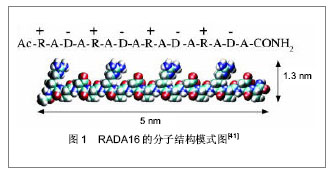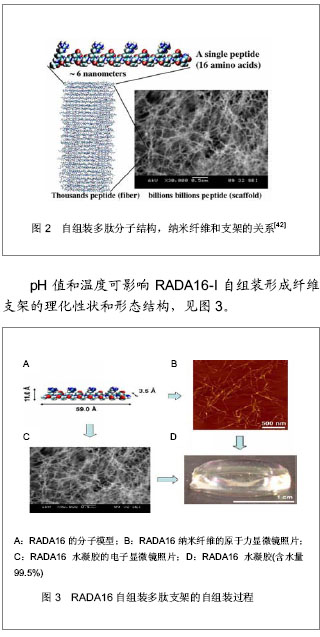[2] Matson JB,Stupp SI.Self-assembling peptide scaffolds for regenerative medicine.Chem Commun.2012;48:26-33.
[3] Li WJ,Tuan RS. Fabrication and application of nanofibrous scaffolds in tissue engineering. Curr Protoc Cell Biol. 2009; Chapter 25:Unit 25.2.
[4] Wang B, Shao Z. Application of self-assembling peptide nanofiber scaffold in nerve tissue engineering.Zhongguo Xiu Fu Chong Jian Wai Ke Za Zhi. 2009;23(7):861-863.
[5] Vasita R,Katti DS. Nanofibers and their applications in tissue engineering. Int J Nanomed.2006;1(1): 15-30.
[6] Dagdas YS,Tombuloglu A,Tekinay AB,et al.Interfiber interactions alter the stiffness of gels formed by supramolecular self-assembled nanofibers.Soft Matter. 2011; 7:3524-3532.
[7] Schneider JP,Pochan DJ,Ozbas B,et al.Responsive Hydrogels From the Intermolecular Folding and Self-Assembly of a Designed Peptide. J Am Chem Soc. 2002; 124:15030-15037.
[8] 孙丽娟,赵晓军.氨基酸序列和时间对短肽纳米纤维形成的影响[J].生物医学工程学杂志, 2009,26(6):1276-1280.
[9] Jackson AR,Yuan TY,Huang CY,et al. Effect of compression and anisotropy on the diffusion of glucose in annulus fibrosus.Spine (Phila Pa 1976) .2008;33(1):1-7.
[10] Cormier AR,Ruiz-Orta C,Alamo RG,et al.Solid state self-assembly mechanism of RADA16-I designer peptide. Biomacromolecules. 2012;13(6):1794-1804.
[11] Sun L,Zhao X.A self-assembling peptide RADA16-I integrated with spider fibroin uncrystalline motifs.Int J Nanomedicine. 2012;7:571-580.
[12] Cheng L,Englander O,Paravastu A,et al.An effective continuum approach for modeling non-equilibrium structural evolution of protein nanofiber networks. J Chem Phys.2011; 135(5):055102.
[13] Ye Z,Zhang H,Luo H,et al.Temperature and pH effects on bio- physical and morphological properties of self-assembling peptide.RADA16-I.J Pept Sci.2008;14:152-162.
[14] Mata A,Hsu L,Capito R,et al. Micropatterning of bioactive self-assembling gels. Soft Matter.2009;5:1228-1236.
[15] Navarro-Alvarez N,Soto-Gutierrez A,Rivas-Carrillo JD,et al. Self-Assembling Peptide Nanofiber as a Novel Culture System for Isolated Porcine Hepatocytes. Cell Transplantation. 2006;(15): 921-927.
[16] Zhang S,Gelain F,Zhao X.Designer self-assembling peptide nanofiber scaffolds for 3D tissue cell cultures. Semin Cancer Biol.2005;15(5):413-420.
[17] Yang SH,Wu CC,Shih TT,et al. Three-dimensional culture of human nucleus pulposus cells in fibrin clot: comparisons on cellular proliferation and matrix synthesis with cells in alginate. Artif Organs.2008;32(1): 70-73.
[18] 黄任平, 宋纯, 张增岭, 等. 3D自组装肽纳米纤维支架对胰岛细胞分泌功能的影响[J].中国组织工程研究与临床康复,2011, 15(42): 7863-7867.
[19] Wang B,Wu Y,Shao Z,et al.Functionalized self-assembling peptide nanofiber hydrogel as a scaffold for rabbit nucleus pulposus cells.J Biomed Mater Res A. 2012;100(3):646-653.
[20] Genové E,Shen C,Zhang S,et al. The effect of functionalized self-assembling peptide scaffolds on human aortic endothelial cell function. Biomaterials. 2005; 26(16): 3341-3351.
[21] Mi K,Wang G,Liu Z,et al.Influence of a Self-Assembling Peptide,RADA16,Compared with Collagen I and Matrigel on the Malignant Phenotype of Human Breast-Cancer Cells in 3D Cultures and in vivo. Macromol Biosci. 2009;9: 437-443.
[22] Guo J,Su H,Zeng Y,et al.Reknitting the injured spinal cord by self-assembling peptide nanofiber scaffold. Nanomedicine. 2007;3(4):311-321.
[23] Semino CE,Kasahara J,Hayashi Y,et al. Entrapment of migrating hippocampal neural cells in three-dimensional peptide nanofiber scaffold.Tissue Eng.2004;(10):643-655.
[24] Holmes TC,Lacelle SD,Su X,et al.Extensive neurite outgrowth and active synapse formation on self- assembling peptide scaffolds.Proc Natl Acad Sci U S A.2009;97(12): 6728-6733.
[25] Tysseling-Mattiace VM,Sahni V,Niece KL,et al. Self-assembling nanofibers inhibit glial scar formation and promote axon elongation after spinal cord injury. J Neurosci. 2008;28(14):3814-3823.
[26] Moradi F,Bahktiari M,Joghataei MT,et al. BD PuraMatrix peptide hydrogel as a culture system for human fetal Schwann cells in spinal cord regeneration. J Neurosci Res.2012;90(12):2335-2348.
[27] Leung GK,Wang YC,Wu W.Peptide nanofiber scaffold for brain tissue reconstruction. Methods Enzymol.2012; 508: 177-190.
[28] Liedmann A,Rolfs A,Frech MJ.Cultivation of human neural progenitor cells in a 3-dimensional self-assembling peptide hydrogel.J Vis Exp.2012;(59):e3830.
[29] Cunha C,Panseri S,Villa O,et al. 3D culture of adult mouse neural stem cells within functionalized self-assembling peptide scaffolds. Int J Nanomedicine. 2011;6:943-55.
[30] Cigognini D,Satta A,Colleoni B,et al.Evaluation of early and late effects into the acute spinal cord injury of an injectable functionalized self-assembling scaffold. PLoS One. 2011; 6(5):e19782.
[31] Matson JB,Newcomb CJ,Bitton R,et al.Nanostructure-templated control of drug release from peptide amphiphile nanofiber gels. Soft Matter.2012;8(13):3586-3595.
[32] Kim JH,Jung Y,Kim BS,et al.Stem cell recruitment and angiogenesis of neuropeptide substance P coupled with self-assembling peptide nanofiber in a mouse hind limb ischemia model.Biomaterials.2013;34(6):1657-1668.
[33] Wang T,Zhong X,Wang S,et al. Molecular Mechanisms of RADA16-1 Peptide on Fast Stop Bleeding in Rat Models.Int J Mol Sci.2012;13(11):15279-15290.
[34] Guo HD,Cui GH,Yang JJ,et al.Sustained delivery of VEGF from designer self-assembling peptides improves cardiac function after myocardial infarction. Biochem Biophys Res Commun. 2012;424(1):105-111.
[35] Chen K,Sahoo S,He P,et al.A hybrid silk/RADA-based fibrous scaffold with triple hierarchy for ligament regeneration.Tissue Eng Part A.2012;18(13-14):1399-1409.
[42] Schneider A, Garlick JA, Egles C.Self- assembling peptide nanofiber scaffolds accelerate wound healing.PLoS One. 2008;3(1):e1410.


